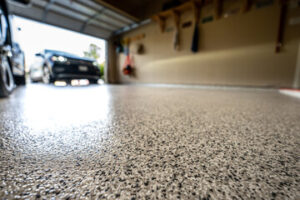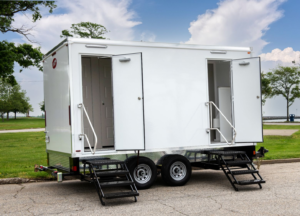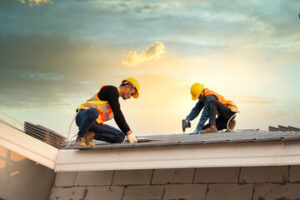Many Garage Epoxy Coating kits include color flakes to add dimension and take away attention from any cracks or stain spots. Using a paintbrush, evenly spread the flakes across the wet epoxy.

Installing a garage floor coating requires thorough surface preparation that includes both mechanical and chemical cleaning. Moisture testing also helps ensure proper adhesion.
Garage floor epoxy coatings are designed to be long-lasting. They are resistant to abrasions, chemicals, impact and impact damage, so you can feel confident that they will last for years. These durable coatings look like new even after heavy use, reducing the need for regular reapplication and maintenance.
There are several options for an epoxy garage flooring system, based on your preference for aesthetics and durability. Epoxy Resin Coatings are the most popular choice, with a gloss finish that’s easy to keep clean and looks great. Epoxy can be topped with color flakes to create an attractive, personalized garage floor design. Epoxy is textured to offer slip resistance, which can help reduce the risk of falls.
Epoxy Resin is also highly resistant to moisture, making it ideal for garages that experience frequent precipitation and humidity changes. Polyaspartic is another option, which offers a fast installation process and high chemical resistance. Polyaspartic is not as sensitive to hot or cold temperatures, so it can be applied year-round.
Both epoxy and polyaspartic are able to withstand impacts and heavy foot traffic, but solid epoxy offers better impact protection than water-based epoxy. Solid epoxy is also denser, so it can withstand heavier equipment and machinery. If you’re looking for a lighter-duty option, water-based epoxy may be the best choice.
A quality, professional garage flooring contractor can advise you on the best type of epoxy for your garage floor. They will be able to provide a range of installation and warranty options to suit your needs.
Regardless of the type of epoxy you choose, it’s important to ensure that the surface is prepared correctly before application. This includes sanding down the existing concrete and removing any oil or grease spots. It’s also important to follow the manufacturer’s instructions for installation and curing. A professional will have the knowledge and equipment to prepare your garage floor and apply the epoxy coating correctly, ensuring that it will be rock-solid and ready for heavy-duty use. For added peace of mind, a good garage flooring company will offer a warranty for their work.
Resistance to Chemicals
Garage floors are exposed to a variety of automotive fluids and household solvents such as oil, gasoline, paint thinner and cleaning products that can wreak havoc on concrete surfaces if they are not properly protected. Epoxy coatings provide an impenetrable barrier that prevents these chemicals from seeping into the concrete substrate, preventing stains and long-term damage.
The epoxy resin and hardener in an epoxy floor coating are engineered to resist high temperatures without softening or degrading, which can occur with traditional floor paints and sealers. Epoxy floors are also capable of withstanding the intense heat generated by car tires, ensuring your garage floor remains resilient and sturdy even in extreme conditions.
An epoxy coating can completely transform the appearance of your garage and can be designed to reflect the style and color scheme of your home. It is highly stain resistant and can be cleaned easily, allowing you to wipe away any spills and splashes before they have a chance to leave behind marks and stains.
Epoxy floor coatings are also an effective barrier against chemicals that can cause stains and discoloration on concrete surfaces, including acid and chemical spills. Epoxy floor coatings are extremely durable and can withstand a range of chemicals, ranging from battery acid to rust remover, as well as common household solvents such as paint thinner and oil.
A quality epoxy coating can last up to 20 years or more, proving to be an affordable investment for your home that will save you money in the long run. It is important to hire a reputable professional company that has experience in epoxy flooring installations and can guarantee their work.
For the best results, your garage floor must be properly prepared prior to applying an epoxy coating. This includes grinding or shot blasting the surface to remove any existing coatings and roughen up the concrete, allowing it to bond with the epoxy. Additionally, it is important to sweep the surface to remove any dust or debris.
Shock Resistant
A hard and thick coating provides a surface that is highly resistant to impact, chipping, surface abrasion, chemical damage, and even water penetration. Garage floors are often subjected to abrasion from metal wheeled tool boxes, floor jacks and other equipment that might be dropped or dragged across the surface. An epoxy floor is also very tough, so these items will typically not damage or chip the coating.
Epoxy is a great choice for a garage floor because it offers superior stain resistance and looks good. It is available in a variety of colors and styles, and it can be used with decorative color chips to create a unique appearance that will make your garage stand out from the rest.
An epoxy floor can be extremely slippery when wet, but an anti-slip media can be mixed into the coating if safety is a concern. Many of the professional products we use have this added to the finish, which will reduce the likelihood of slipping and falling when the floor is wet.
While standard epoxy coatings are a popular option for residential garage floors, there are a number of other high performance options that can be used in commercial applications. Urethane cement flooring is a thick and durable material that has the highest chemical resistance of any topical coating. This material is typically used in manufacturing installations where it can withstand intense use and exposure to chemicals and other harsh materials.
In addition to offering exceptional durability, urethane cement also has good thermal shock resistance. This is important because it can withstand the extreme temperature fluctuations that occur in most garages. It is also very easy to clean, which makes it an ideal flooring material for garages that are used as workshops or for other types of commercial or residential activities.
Epoxy floor coating can be very expensive, but it will last for a very long time and will keep your garage looking new. We frequently get calls from homeowners who have gone to a big box store or bought an epoxy kit on their own and found that it didn’t give them the protection they wanted, didn’t hold up well under traffic or had to be removed and replaced in just a few years. This is why it’s so important to do your homework and only use a company that knows what they are doing.
Easy to Clean
A quality epoxy floor coating is very easy to clean. In fact, it’s much easier to keep your garage or shop clean than a concrete surface. A good floor coating is stain resistant and very tough. Besides, it has a gloss that no regular paint can match. It is also mold & mildew resistant.
Proper cleaning is one of the most important factors for a long lasting and durable Garage Epoxy Coating. A dirty and contaminated concrete surface will not allow the epoxy to form permanent chemical bonds with it. This can cause the epoxy to debond over time and create severe flaws on the garage floor.
One of the best ways to prevent this is to sweep your garage or shop regularly. Sweep the floor at least once a day to remove any dirt and grit before it has a chance to become embedded in the epoxy coating. This will help to protect the color base coat from scratches and other damage.
In addition to daily sweeping, you should also scrub your garage or workshop floor on a weekly basis. This will help to remove any chemical spills or oil stains that may occur. A commercial grade rust, lime & calcium cleaner can be used to remove these types of stains. It’s recommended that you mix the cleaner with water at a ratio of 1:1 and then either spray it on the floor or mop it with a deck brush that has nylon bristles.
If you want to take a more preventative approach you can also use an oil & grease repellent product that can be sprayed or mopped on the floor. It can help to extend the life of your garage floor and reduce the need for frequent cleaning.
For those looking to make their garage or workshop a little more beautiful we can add a clear epoxy topcoat. This will not only give you enhanced durability but it will also hide any unsightly tire marks or oil stains that might occur. This is a great option for those that do not want to spend the money on a full color or metallic epoxy flooring system.








